
President Franklin D Roosevelt

President Franklin D Roosevelt
The handwritten inscription on the photo above reads:
'For my friend Richard St Barbe Baker
from his fellow "Man of the Trees"
[signed] Franklin D Roosevelt'
Shortly after becoming President of the United States in 1933, Roosevelt established the Civilian Conservation Corps which helped put a nation back to work.
Baker had presented the concept to Roosevelt the previous year in a private meeting in Albany, New York. Roosevelt had embraced the idea and immediately began expanding it.
Upon Roosevelt taking office, he and Baker wrote each other and Baker then met with Roosevelt's right-hand man, Henry Morganthau Jr., to impart the vision and discuss the economics involved. The rest is history.
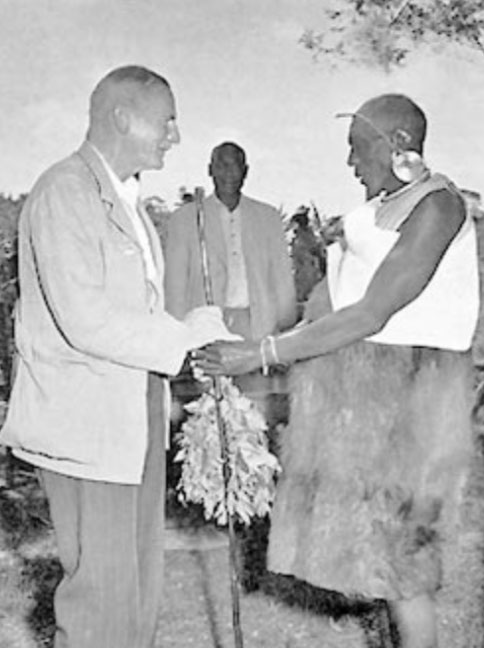
The Staff of the Kiama
Upon his return to Kenya in 1953 after a thirty-year absence, St. Barbe is presented with the staff of the Kiama by Thotho Thongo. Chief Josiah Njonjo beams his approval in the background. The Kiama is the honorary secret society of elders of the Kikuyu people into which St. Barbe was initiated in 1922.
In 1966 Richard St. Barbe Baker received the Freshel Award, an annual prize for the book making the greatest contribution to humanity, from the Millenium Guild of New York for Sahara Conquest.
In 1978 Richard St. Barbe Baker was awarded the Order of the British Empire by Her Majesty Queen Elizabeth II of Great Britain.
In 1969 Richard St. Barbe Baker was made the first Honorary Life Member of the World Wildlife Fund.

Richard St. Barbe Baker
"Richard St. Barbe Baker has earned for himself the reputation of being the greatest living authority in the English-speaking world on the supreme value of silviculture..."
Viscount Bledisloe, Governor-General of New Zealand, 1956
Ahead of His Time
"His story is ultimately about the establishment of global prosperity and hope for an end to famine. Although Richard St. Barbe Baker has been dead for more than twenty years, his message is for the present and future.
Baker was an idealist who 'walked the talk,' translating his goals into a blueprint for international cooperation... [He was] a remarkable human being whose status and influence will increase with time.”
Lester R. Brown, President, Earth Policy Institute, 2004
St. Barbe touched many, many hearts by his example of dedication to earth renewal.

Child and St.Barbe
I was asked to assist St. Barbe first on a trip to Saskatoon* in 1975. I was Secretary of the Local Spiritual Assembly of the Bahá’ís of Saskatoon. St. Barbe lived his life assuming others would arise to assist his efforts. He worked with those who were receptive. He charmed and regaled any audience, whether assembled for an arranged event or informally, with stories of his life and moving excerpts recounted by memory from his books. He would appear rehearsed but fully open to opportunity to engage those he met.
He would arrive to the city of Saskatoon with short notice and there would be a large box of correspondence forwarded to the University of Saskatchewan for him, postage stamps from around the world. I learned much later that some of these contained cheques and even cash to support his work. St. Barbe was in his old age, I am sure he faced much uncertainty, but he was on a mission and delighted and encouraged especially in meeting young people who could get animated and be inspired by his vision. In this he had charisma but was also an enigma. Did he really do all the things he claimed? How and why is he on his own in his travels? Some would dismiss him maybe as a quack – he was not a polished academic, his career path was diverse and erratic, he had too much vision – St. Barbe would move on to those receptive. He promoted the centrality of ecological literacy – the photos of St. Barbe with children are particularly inspiring. He had seen nearly a century of destruction of earth’s green mantle. He had hope for future generations.
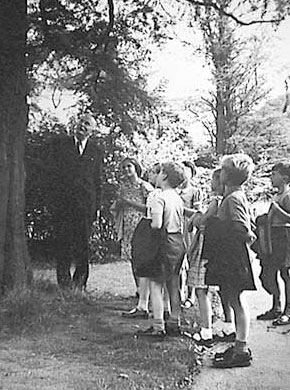
Children and tree
I remember him drawing curvilinear forms of shelterbelts and mixed crops, for soil conservation, food security, and biodiversity, as his vision for a transformation of industrial agriculture at a large scale on the Canadian prairies. The images were reminiscent of configurations now promoted as permaculture.
He died in Saskatoon, I expect pleased he’d completed a long circle since his years of study at the University, to be buried across the river under three tall spruce at the Woodlawn Cemetery from where one can see the University campus on the crest of the bank. Last year, under the initiative of Robert White, we had a commemoration of the last tree we had planted together with him on World Environment Day, June 5, 1982, a few days before he died. St. Barbe drew together a group of us who shared interests in ecology, inspired by this determined soul.
If you ever come to Saskatoon, stop by for a visit to his ‘homestead’ land (never proved up), south of the city, which is now part of the Beaver Creek Conservation Area and open to the public.
*Saskatoon Saskatchewan is an odd sounding name to those not familiar. It is Cree for ‘good tasting berries’ (Saskatoons, also known as service berries) by the ‘fast flowing water’ – the South Saskatchewan River.
David van Vliet, PhD, MCIP,
Associate Professor, Dept. of City Planning and Environmental Design Faculty of Architecture,
University of Manitoba, Winnipeg, Canada
We first met Dr. St. Barbe Baker in 1954 in Dunedin, New Zealand, giving talks on his dedicated subject, the trees. The first time St. Barbe arrived in New Zealand was early in 1931 at the invitation of Lord Bledisloe, at that time Governor General of New Zealand, to try and solve the unemployment problem in that country. Thousands of men on relief benefit were put to planting trees. The result is New Zealand’s forestry, now a great economic asset to the nation.
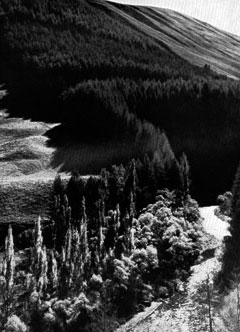
River protection by a mixed planting of trees
Jollie River, Mt. Cook Station, Canterbury, New Zealand
Later, when he made permanent residence in New Zealand on the Mt. Cook Station and we moved to Oamaru, we saw much of each other. We gave talks in different towns of the South Island…
When we migrated to Sydney, we then had the pleasure of seeing him on each of his journeys overseas. On his last trip, which was to Canada, he was to stay in Sydney with us before his return to New Zealand; but the hand of destiny had a different plan, and he is laid to rest in Canada, the country he loved and admired so much.
Only a few men in history become the cause for humanity’s upliftment, or its degradation… St. Barbe was one of those universal benefactors. He saw the world as one country and the human race as one family and he defended the preservation of trees and promoted their propagation. To these ends he laboured with great urgency, day and night, to awaken global awareness… How often he said that if only the armies of the world fought the deserts and conquered them instead of fighting and destroying each other…
He traveled for some 60 years throughout the world. He knew many kings and rulers in both East and West. He was loved and admired and welcomed everywhere because he came to give, expecting no reward. He was a giant who did not feel superior in the presence of a beggar, not inferior in the presence of a king, but at one with all people.
I remember him telling us of flying to Iran during the Shah’s reign, with a box of seedlings on his lap for a Bahá’í project in Tehran. The Customs officials were up in arms: “Impossible, impossible!” By the time St. Barbe finished explaining in his persuasive manner, they shook hands and welcomed him and his “gift.”
His youthful enthusiasm was with him right to the end of his life. A lifetime was not long enough for him to accomplish his dream, but he has sown the seeds – billions are growing already! But what he has sown in the human heart is even more precious and fruitful…
When he crossed the Sahara Desert in a car, he came upon some travelers whose tyre had perished. They also would have, if St. Barbe had not given them his only spare tyre, disregarding the fact that if the same thing happened to him without his spare tyre, he would also perish!
St. Barbe combined dignity and simplicity; he was an aristocrat, but above all, honest and compassionate. He could afford it, as he never wanted anything for himself, but only for the world. Our oldest son was the executor of his will. The legacy he left for mankind was beyond the need for an executor. Our admiration, love and affection for this dedicated man of vision, a lover of this one world and its people, has left us all richer…

The friendship of Richard St. Barbe Baker and Chief Josiah Njongo spanned six decades, transcending barriers of time, distance, culture and race.
They were born on the same day and celebrated their 88th birthdays together.
During the so-called Mau Mau uprising – a terrible time of much suffering and bloodshed – St. Barbe persuaded a chief [Josiah Njonjo of Kenya] to go with him to London and to put his case to the Queen. This was the chief of an area that had been under St. Barbe’s direction [as Assistant Conservator of Forests] and where people had been taught conservation and were able to grow enough food. The chief left his son in charge. During his absence, the Mau Mau leaders prevailed upon his son to take up arms. He did, and committed suicide, rather than take others’ lives.
St Barbe felt sad and defeated and blamed himself for such an outcome. He told the grieving mother that he would come back and rest his bones next to her son’s. “St. Barbe, there is no need for that,” she replied. “We already have your heart.”
Indeed, she is not the only one.
ANTHONY VOYKAVIC
Reprinted from Herald of the South, Vol. 21, Oct-Dec 1989. Edited for length and content. Two photos with captions added.
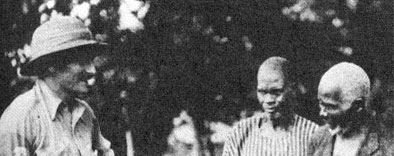
Richard St. Barbe Baker, on the left, in the 1920s
...In the realm of forestry one name must stand out, that of a man of enormous energy and all-encompassing vision, who foreshadowed and inspired the present worldwide Green movement, and even shared Gandhi’s conviction’s linking a postindustrial society with lasting peace. This man was Richard St. Barbe Baker, who, as a young forester in 1922, founded the Men of the Trees in Kenya, a country that is now playing a leading role in tree-planting and which holds the headquarters of the International Council for Research in Agroforestry. [now also Kenya's Green Belt Movement.]
In his book, My Life My Trees, St. Barbe describes the devastation of the forests in the Kenya highlands caused by nomadic herdsmen, land-hungry white settlers, and logging contractors.

Goats do great damage to trees
The young forester’s response was to demarcate a wide area and get it designated as a forest reserve. With the cooperation of a man who was to be his lifelong friend and colleague, the Kikuyu chief Josiah Njonjo, St. Barbe had thousands of indigenous trees planted between rows of grain and yams—an agroforestry system. At the same time he started Kenya’s first large tree nursery, planting olives in conjunction with Mutarakwa cedars, an association found in the natural forest. Thus, from the first, as he admitted, St. Barbe took advantage of the local tradition of mixed cropping.
Later St. Barbe became responsible for the sustainable development of mahogany rain forests in Nigeria, where he observed another example of plant symbiosis:
"Each mahogany is surrounded by numerous trees belonging to other families, amongst which is that important family of Leguminosae—the soil improvers. These I have observed to be good nurse trees for the mahoganies. The more important species of mahogany require the services of a succession of nurse trees throughout their life to bring them to perfection. Some of these provide just sufficient competition to coax the young sapling upwards. Others do their work in secret under the surface of the soil, interlacing the roots, a sort of symbiosis, like the mycelium, which starts as an independent weblike growth, surrounds the sheath of plant rootlets and prepares food that can be assimilated by the growing trees."
In the 1950s and 1960s St. Barbe undertook two extensive expeditions through and around the Sahara, and put forward a breathtaking plan for the reclamation of the world’s largest desert by progressive tree-planting.

Once desert -- this land was fully reclaimed after 25 years of reforestation (northern fringe of the Sahara)
...St. Barbe...encouraged the Saharan states that he visited to proceed with schemes best suited to their individual talents, policies, and resources. He was particularly impressed by large-scale desert colonization schemes being pioneered by Egypt, one of which involved five-acre family orange groves with leguminous crops such as peanuts and cowpeas growing beneath the trees.
While water for some of the projects was provided by irrigation channels from the Nile, in other cases wells were sunk, some of depths as great as 3,600 feet. Ancient wells, some going back to Roman and pre-Roman times, were discovered and opened up. There is said to be an underground sea the size of France beneath the Sahara. This could doubtless be made available for irrigation by modern oil-drilling techniques.
The remains of ancient civilizations have been found near the center of the Sahara. Their water supplies must have been ensured by the presence of forests, but when these were cut down and regeneration made impossible by browsing animals, the water table, maintained by the trees’ roots, would have sunk to great depths.
St. Barbe’s vision of a Green Belt round the Sahara was revived at an exhibition in London in October 1989, sponsored by a number of relief agencies. The exhibition did not envisage an endeavor to plant a continuous shelterbelt round the desert’s perimeter, but a mosaic of protective zones, comprising forests of drought-resistant trees and crops, which would eventually merge.
Innumerable forms of land use practiced in Africa, Asia, and Latin America, whether traditional or extemporized, have agroforestry characteristics. It is being increasingly recognized that symbiotic systems, involving the integration of trees with other crop plants, constitute a vast and complex subject of study, which contains the seeds of a comprehensive new-old technology for meeting all basic human physical needs.
ROBERT HART
Excerpted from Robert Hart's Forest Gardening, pp. 113-116, Chapter 11, "Agroforestry Against World Want," Copyright © 1996, Chelsea Green Publishing Company, White River Junction, Vermont. Reprinted with permission.
In referring to St. Barbe, reknowned American broadcaster and journalist Lowell Thomas (1892-1981) once declared on his radio show: "I believe he'll marry a tree one of these days!" In 1931 he wrote the following in describing Richard St. Barbe Baker:
"In his love for forestry he wears his heart on his sleeve. His manner becomes animated. His eyes widen. He speaks with a rushing enthusiasm - the wonder of trees - the necessity of forest conservation - how fair fields will turn into desert if they keep destroying trees - how arid wastes will bloom with the greenness of life and the colors of flowers, if they will reforest. You feel the passion and earnestness of the man who has given his life to a great devotion. You sense the singular turn of poetry and exultation in the man who is in love with trees."
An excerpt from the lead article, "The Next Step" in Manas, April 10, 1985:
In 1894 a child was lost in the forest near Hampshire in England. Who was the child? He was Richard St. Barbe Baker, and this little boy lost fell in love with the trees. As Paul Hanley, who lives in Saskatchewan, where St. Barbe went to school, has said in the current Structurist:
For nine decades that child will grow in his affinity for trees; their fate will be entwined with his own. He will mobilize people on every continent to plant and protect trees; he will awaken thousands to the oneness of humanity and all living things, and to the healing of the earth. He will be the Man of the Trees.
Let us have no more talk of self-interest as the only spring of action in human beings.
After interviewing St. Barbe in 1977, journalist Cameron Smith of the Toronto Globe and Mail wrote:
Dear Dr. Baker,
As the forests are the fountains of life, so you stand at the headwaters of consciousness. May we all join you there one day...
Richard St. Barbe Baker visited Northern Ireland in June of 1978. He stayed for two nights at our home in Londonderry.
I remember that—as a considerate guest—he had with him a ‘sheet sleeping bag’, so as not to use our bed linen! When the word got around that he was in the city, we had visitors to the house. People seemed to regard him with awe, including a local solicitor, David Gilliland, who called to see him. Mr. Gilliland lived in a grand, historic, riverside house, Brooke Hall, set in a demesne, with an arboretum that contained several Redwoods. We duly went to visit this collection of trees, and I was treated to the spectacle of St. Barbe hugging one of these giants!
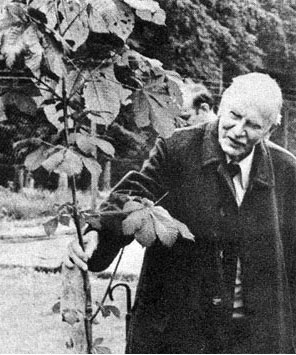
St.Barbe and tree
While in the city, St. Barbe gave a well-attended talk at Magee University College, a part of the New University of Ulster, and he also planted some trees there. In St. Columb’s Park, he planted a Horse Chestnut with the then Lord Mayor of the City.
St. Barbe was taken to Coleraine, and gave a talk at the main campus of the New University. After Londonderry, he went on to visit other Northern Ireland Bahá’í communities.
Not that long after the visit, I became a member of ‘The Men of the Trees’ (MOTT) and then moved to Omagh. In 1987 I was involved in the formation of a Northern Ireland Branch, the second of the four regions of the United Kingdom, after England, to have a MOTT presence. Even then, there were probably 30 members in Northern Ireland. I have continued to be part of the Branch Committee ever since. For a period I also served on MOTT’s National Committee.
From the start, the Northern Ireland Branch was, and is still, involved in visiting and educating primary school pupils on the importance of trees, and planting trees with them on their schools’ invariably bare sites. Furthermore, the Branch has regularly contributed to government consultation documents, frequently referring to St. Barbe’s ideas as a solution to situations that are presented.
Richard St Barbe Baker: what charisma! What single-mindedness! He came across as someone from another age, extremely polite and formal; small talk didn't seem to come easy, probably due to his Edwardian heritage. His invention of ‘social forestry’, however—involving ordinary people in the planting and protection of trees on a massive scale—was a seminal idea. And the logic that, for safety, one third of the land area of the Earth should be growing trees, cannot be faulted.
Without doubt, Richard St. Barbe Baker was a very original thinker—with the physical, social and spiritual health of planet Earth foremost in his mind.
MALCOLM LAKE
Omagh, Northern Ireland, March, 2005
Mrs. Madeline Hellaby of England shares this memory from September 29, 1978:
St. Barbe's third visit was a great success and at the meeting organized by the Skipton Civic Society he was, as I say in my diary, on top form. His talk lasted an hour and he was standing the whole time. He was about 90, I think.
After the talk, during Question Time, a young man at the back of the hall, who obviously thought St. Barbe was an old man and he could probably demolish him in no time, asked a question which he thought St. Barbe wouldn't be able to answer. Well, he learnt his lesson. St. Barbe was bang up to date and knew everything there was to know about trees and the world scene regarding them and he wiped the floor with him.
We thought it was rather funny, actually!

RICHARD St. BARBE BAKER
There is a kind of logic that I should glimpse this gentleman visionary in that other place of visions, Findhorn. That a recluse living in a tumbledown keeper's cottage in a wood knew this man as a bit of a father, a bit of a brother, a bit of a friend, and above all as a teacher. In the seventies, I searched the catacombs of Hay-on-Wye for cheap copies of St. Barbe Baker's books - I Planted Trees; The Brotherhood of The Trees; The Redwoods; and others. Always I glimpsed the paradox of this strange man, quintessentially English yet looking at the world not as an Englishman, someone thinking about trees for the sake of the planet. A private person yet a consummate showman if it could put another tree into the ground; a friend of aristocrats (often notable foresters) yet someone who dreamed of living in a caravan community in a wood; the forester with degrees from Cambridge University and a blood brother with African chiefs. I could not pigeonhole this man; even his closest friends did not know he was a member of the Bahá’í Faith. While contemporaries embarked on doomed peanut schemes in Tanzania, he urged people to plant trees to halt the spread of the Sahara. He liked to be called 'Sahara' Baker. A man, definitely, before his time.
I was on familiar ground in the insect garden of Bruce Burdass, off a lane and down a track near the Wiltshire village of Compton Bassett. An unlikely place for this urbane pilot who once owned 500 acres in Kent. I never sought for an explanation or got one. He had been a friend of Richard St. Barbe Baker for thirty years; at 40, the youngest council member for The Men of the Trees, the organisation founded by his mentor with the Kikuyu tribes in Kenya in 1922. That helped to change the traditional attitude of planting trees as God's work, to the work of warriors, comradeship against the desert. Bruce recalled for me the tall, meticulous man in dress and manners (but never showy) he first met at Penshurst when St. Barbe Baker had politely announced that he was vegetarian, refusing the leg of lamb. 'He had walked twice around the Sahara when I met him. And later I walked a thousand miles with him in ten African countries bringing seeds and knowledge to the tribal peoples. In 1974, as a birthday treat, I flew St. Barbe Baker over the plantations which he had personally planted by Mt. Kenya.'
He was a man who considered he had a purpose, said Bruce, yet at 70 felt his pleas for reafforestation, particularly in the Sahel, were not being listened to. His treatment of the African as equals in the 1930's, his lack of interest in bureaucracy, and the codebook of rules against new ideas did not endear him to the colonial administration. 'There was no tittle-tattle in him, or any falseness, just factual. He could see through people. A lot tried but you couldn't fool him, yet with a genuine audience he could talk about trees for hours... Some people found him intense.' St. Barbe Baker often used his London home as a bolthole, arriving on his doorstep with rucksack or suitcase and sleeping bag. He travelled all over the world with his tree message, largely at his own expense, Bruce emphasizes. His training as an ex-army officer extended into his civilian life. (Once he had been a cavalry officer and in his youth retraced Cobbet's ride in Hampshire). Up at 5:30 writing for three hours before breakfast of nuts and berries. 'He was very hard-working and deeply conscious that if he could only get his views across he could save millions of lives.'
He thought about trees in big numbers. Bruce remembers sitting on a verandah at Tree-Tops, a reserve near Nairobi, listening to the bush at 3 am. They watched a beetle the size of a plate crawl to the waterhole, then two torchlights appeared and a jungle owl swooped down and grabbed it. Crunch! 'It's larger than life,' I said. 'That's what I wanted you to see,' said St. Barbe Baker. 'It's the scale that matters.' He pictured the world as a new tennis ball and the fluffy bits are trees. When they wear out the ball spins faster and the earth's natural equilibrium is endangered. 'He didn't see the world as an Englishman. He didn't consider himself to be any particular nationality. He was a citizen of the world. He was a loner though he never considered himself to be out on the edge. He felt he was the one in step. I think time has proved him right.'
I'm proud that I met him once even though I never spoke to him. In 1976 I saw his face in a candle-lit meditation, alive, alert and serene. He was 87-years-old. He told a visitor at breakfast that he was always intoxicated by the love at Findhorn. He is buried under a tree in Canada.
PETER ALFRED PLEASE
From Holine: A British Journey , Bulletins from the Wayside, 1950-1997 by Peter Alfred Please, Copyright 1997, Away Publications. Reprinted with permission.
Two books of recent years lavishly praise Richard St. Barbe Baker

Brave Hearts, Rebel Spirits
Brave Hearts, Rebel Spirits - A Spiritual Activists Handbook, by Brooke Shelby Biggs, was published by Anita Roddick Books in 2003. Chapter 10 (of ten) is titled: “Man of the Trees, Richard St. Barbe Baker, Baha'i Conservationist.” Ms. Biggs states point blank in the opening paragraph, "He was the world's first global environmentalist..."
While it reveals no new information bearing upon his legacy, Brave Hearts, Rebel Spirits does include this account (perhaps derived from one of St. Barbe’s many books):
In 1958, St. Barbe went to Washington to speak at a Senate hearing on a wilderness bill then being considered. He heard ranchers, miners, loggers, and farmers argue for "multi-use" designations of federal lands. St. Barbe said "multi-use" was just a euphemism for "multi-destruction." Before he was called to testify, the slight, dignified Englishman rose quietly and left the Senate chambers without a word. "I felt I could no longer contribute even a note of sanity in a madly industrialized world, speeding to its doom," he recalled.
Brave Hearts, Rebel Spirits has the laudable motive of inspiring the reader to work for social change. However, it has an ambitious scope – attempting to profile some thirty-four wide-ranging activist groups and individuals in less than 250 pages while incorporating lots of photographs and graphics. This makes for a cursory treatment of some of its subjects, although St. Barbe fares better than others in the book. But St. Barbe is not easy to pin down as an historical figure. The resulting treatment is permeated with the usual minor inaccuracies about his life. It generates a few new ones as well.
Overall, however, this book is visually attractive and readable and is to be applauded for identifying Richard St. Barbe Baker in his rightful place as a modern forerunner and seminal figure of the environmental movement. It also recognizes the spiritual underpinning that motivated his life’s work.
On the other hand, Origins of the Organic Movement, by Philip Conford, published by Floris Books in 2001, is a scholarly contribution to the study of agricultural history.

Origins of the Organic Movement
This serious academic work refers to St. Barbe on seventeen different pages, (although the majority of these are mentions in passing). It offers a significant evaluation of St. Barbe's place in history and has a section focused on him in part of Chapter 3, "Shangri-La and Three Servants of Empire." He is grouped, along with Sir Robert McCarrison and Sir Albert Howard, as one of three enlightened progenitors of modern thinking toward the natural world and indigenous people, who arose from the British colonial system:
"...all, objectively speaking, the servants of imperialism through their professional and official status as representatives of colonial power. One could argue, though, that to some extent they 'went native,' in that they believed traditional native culture could offer valuable lessons to the industrial nations...
"...By the mid-1930s [they] were once more based in England, and the conclusions they drew from their colonial experiences would prove central to the critique of English society and Western civilization which the emerging organic movement was to formulate during the next fifteen years.
Conford writes: "St. Barbe Baker's life was one of astonishing vigour and expertise, linking the pre-1914 world of the Canadian prairies with the establishment of the Findhorn Community. It demonstrates the close relationship between the organic movement and religious faith..."

Erosion in Kenya
Further:
St. Barbe Baker's account of Africa tells of a landscape ruined by human thoughtlessness. Only a remnant of natives are concerned about their future, and short-sighted officialdom obstructs the possibility of renewal; but the tribesman are ready to be aroused from their apathy by the inspiration of a westerner's scientific and practical knowledge. Baker's combination of scientific skill and religious reverence anticipates the contemporary work in East Africa of Wangari Maathai and the Green Belt Movement.
This book is especially noteworthy for demonstrating that the early organic movement had strong connections with some prominent right-wing, anti-Semitic, fascist sympathizers. As St. Barbe’s work in forestry and husbandry brought him into contact and even some association with these politically polarized figures, this context makes the body of his writings appear even more courageous by contrast.
The author refers to St. Barbe's New Earth Charter as a "major statement of environmental philosophy and policy." He also states: "Richard St. Barbe Baker helped establish the Findhorn Community." In a summary Conford comments, 'St. Barbe Baker ended up rejecting the whole idea of "progress" based on industrialism, militarism and exploitation of natural resources.'
Origins of the Organic Movement has a number of valuable facts that help to place St. Barbe within the framework of his times. For instance, it refers to a husbandry conference at "Springhead estate in Dorset, under an acacia tree" where he, along with Ehrenfried Pfeiffer (of Rudolf Steiner’s Biodynamic fame), was one of the speakers.
Furthermore the book’s appendices, “Appendix A: Leading Figures” and “Appendix B: Groups, Institutions and Journals,” are extremely useful in sorting out the ‘Who’s who?’ and ‘Who did what?’ in the early organic movement, as it manifested in the British Empire. Conford's astute grasp of his subject is also demonstrated by his reference (quoted earlier above) to the continuum extending from Richard St. Barbe Baker's Men of the Trees to Wangari Maathai's Green Belt Movement. He made this observation three years before Maathai was awarded the 2004 Nobel Peace Prize.
A puzzling omission in Origins of the Organic Movement is that it treats the connection between religion and organic agriculture and surveys the work of Richard St. Barbe Baker, yet makes no reference whatsoever to the Bahá’í Faith. St. Barbe began his association with the Bahá’í religion in 1924. His personal correspondence, autobiographical works, and itineraries all reveal that, from at least February 1935 onward, until his death in 1982, he closely identified himself with the Bahá’í Faith and regarded it as his guiding star.
PAUL MANTLE

Last updated 22 November 2023